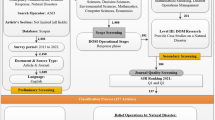Abstract
Central to humanitarian logistics is the minimization of distress among impacted populations in the aftermath of a disaster. In this paper, we characterize two levels of distress, termed criticality and destitution, with respect to the delay provision of relief items. Delay in provision of a relief item will lead to destitution for a tolerable number of days, beyond which it will lead to criticality. We develop a mixed-integer goal program that quantifies these two metrics with respect to the number of days without provision of each of a set of relief items. The model determines the allocation of resources and the distribution of available relief items in a manner that minimizes criticality and destitution in affected population segments. The use of the model is demonstrated for the aftermath of a catastrophic earthquake in Istanbul, expected to occur by 2030.






Similar content being viewed by others
References
Altay N, Green W (2006). ORMS research in disaster operations management. European Journal of Operational Research 175(1): 475–493.
Balcik B, Beamon BM, and Smilowitz K (2008). Last mile distribution in humanitarian relief. Journal of Intelligent Distribution Systems 12(2): 51–63.
Dessouky M, Ordonez F, Jia H, and Shen Z (2006). Rapid distribution of medical supplies. Delay Management in Health Care Systems, pp. 309–338.
Galindo G and Batta R (2013). Review of recent developments in OR/MS research in disaster operations management. European Journal of Operational Research 230(2): 201–211.
Gormez N, Koksalan M, and Salman, FS (2011). Locating disaster response facilities in Istanbul. Journal of the Operational Research Society 62(7): 1239–1252.
Holguin-Veras J, Perez N, Jaller M, Van Wassenhove LN, and Aros-Vera F (2013). On the appropriate objective function for post-disaster humanitarian logistics models. Journal of Operations Management 31(5): 262–280.
Holguin-Veras J, Perez N (2010). Need to reformulate humanitarian logistics modeling to explicitly consider social costs. Transportation Research Board 89th Annual Meeting.
Huang M, Smilowitz K, and Balcik B (2011). Models for relief routing: Equity, efficiency and efficacy. Transportation Research Part E 48(1): 2–18.
Jia H, Ordonez F, and Dessouky M (2007). A Modeling Framework for Facility Location of Medical Services for Large-Scale Emergencies. IIE Transactions 39(1): 41–55.
Japan International Cooperation Agency JICA, Istanbul Metropolitan Municipality (2002). The study on a disaster prevention/mitigation basic plan in Istanbul including seismic microzonation in the Republic of Turkey. Technical Report.
Natarajarathinam M, Capar I, and Narayanan A (2009). Managing supply chains in times of crisis: a review of literature and insights. International Journal of Physical Distribution & Logistics Management 39(7): 535–573.
Ozdamar L, Ekinci E, and Kucukyazici B (2004). Emergency logistics planning in natural disasters. Annals of Operations Research 129(1–4): 217–245
Parsons P (2009). Heightened Odds of Large Earthquakes Near Istanbul: An Interaction-Based Probability Calculation. Science 288(5466): 661–665.
Perez Rodriguez N (2011). Inventory allocation models for post-disaster humanitarian logistics with explicit consideration of deprivation costs.
Rawls CG and Turnquist M (2010). Pre-positioning of emergency supplies for disaster response. Transportation Research Part B: Methodological 44(4): 521–534.
Rawls CG and Turnquist M (2012). Pre-positioning and dynamic delivery planning for short-term response following a natural disaster. Socio-Economic Planning Sciences 46(1): 46–54.
Tzeng GH, Cheng HJ, and Huang TD (2007). Multi-objective optimal planning for designing relief delivery systems. Transportation Research Part E: Logistics and Transportation Review 43(6): 673–686.
Yi W and Ozdamar L (2007). A dynamic logistics coordination model for evacuation and support in disaster response activities. European Journal of Operational Research 179(3): 1177–1193.
Yushimito WF, Jaller M, and Ukkusuri S (2010). A Voronoi-based heuristic algorithm for locating distribution centers in disasters. Networks and Spatial Economics 12(1): 21–39.
Author information
Authors and Affiliations
Corresponding author
Additional information
“Relief material for Jammu & Kashmir lies in neglect on railway platforms.”—The Indian Express, 9-24-2014.
Rights and permissions
About this article
Cite this article
Ali, A.I., Ince, G. Distress among disaster-affected populations: delay in relief provision. J Oper Res Soc 68, 533–543 (2017). https://doi.org/10.1057/s41274-016-0015-4
Received:
Accepted:
Published:
Issue Date:
DOI: https://doi.org/10.1057/s41274-016-0015-4




